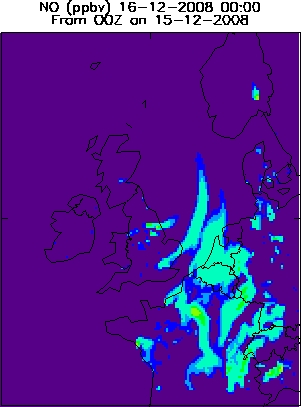Difference between revisions of "Air Quality Forecasting"
(→AQUM - Air Quality in the Unified Model: add info on vertical grid) |
(→AQUM - Air Quality in the Unified Model: update information) |
||
| Line 3: | Line 3: | ||
[[Image:NO_AQUM.jpg|thumb|right|NO from AQUM]] |
[[Image:NO_AQUM.jpg|thumb|right|NO from AQUM]] |
||
| − | The Met Office now performs a daily |
+ | The Met Office now performs a daily 5 day air quality forecast using a limited area version of UKCA. |
The model grid has 12km horizontal resolution with a domain which covers all of the UK and was until 2006 used for operational weather forecasting. It has 38 model levels with the lowest model level 40m deep and the model top at 39km. It includes aerosol as well as gas phase pollutants. The initial meteorological conditions and meterological variables at the model edges come from the Met Office's 12km North Atlantic and European Model. The values of chemical and aerosol tracers at the model edges come from daily global forecasts carried out as part of the [http://www.gmes-atmosphere.eu/ MACC] project. |
The model grid has 12km horizontal resolution with a domain which covers all of the UK and was until 2006 used for operational weather forecasting. It has 38 model levels with the lowest model level 40m deep and the model top at 39km. It includes aerosol as well as gas phase pollutants. The initial meteorological conditions and meterological variables at the model edges come from the Met Office's 12km North Atlantic and European Model. The values of chemical and aerosol tracers at the model edges come from daily global forecasts carried out as part of the [http://www.gmes-atmosphere.eu/ MACC] project. |
||
| − | + | Output from the AQUM model was used to help flight planning for several aircraft campaigns in the UK ([http://badc.nerc.ac.uk/data/ronoco/ RONOCO]; [http://badc.nerc.ac.uk/view/badc.nerc.ac.uk__ATOM__ACTIVITY_e0c03922-bc29-11df-9507-00e081470264 SEPTEX]) as well as for [http://www.clearflo.ac.uk/ ClearfLo]. It is now planned to use these flights for model evaluation and scientific investigations. A year long run of the AQUM model has now also been carried out for participation in a model intercomparison experiment. |
|
| + | |||
| + | The model output undergoes statistical postprocessing and is then used to deliver site specific forecasts of air quality indices on the Met Office webpages. See [http://www.metoffice.gov.uk/about-us/help/guides/air-quality-forecast this page from the Met Office] for more information |
||
Latest revision as of 13:05, 24 August 2012
AQUM - Air Quality in the Unified Model
The Met Office now performs a daily 5 day air quality forecast using a limited area version of UKCA.
The model grid has 12km horizontal resolution with a domain which covers all of the UK and was until 2006 used for operational weather forecasting. It has 38 model levels with the lowest model level 40m deep and the model top at 39km. It includes aerosol as well as gas phase pollutants. The initial meteorological conditions and meterological variables at the model edges come from the Met Office's 12km North Atlantic and European Model. The values of chemical and aerosol tracers at the model edges come from daily global forecasts carried out as part of the MACC project.
Output from the AQUM model was used to help flight planning for several aircraft campaigns in the UK (RONOCO; SEPTEX) as well as for ClearfLo. It is now planned to use these flights for model evaluation and scientific investigations. A year long run of the AQUM model has now also been carried out for participation in a model intercomparison experiment.
The model output undergoes statistical postprocessing and is then used to deliver site specific forecasts of air quality indices on the Met Office webpages. See this page from the Met Office for more information
